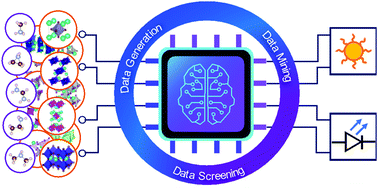High-throughput computational design of organic–inorganic hybrid halide semiconductors beyond perovskites for optoelectronics†
Abstract
Organic–inorganic lead halide perovskites show great promise in optoelectronic applications such as light-emitting diodes and solar energy conversion. However, the poor stability and toxicity of lead halide perovskites severely limit their large-scale applications. Here we show a high-throughput design of lead-free hybrid halide semiconductors with robust materials stability and desired material properties beyond perovskites. On the basis of 24 prototype structures that include perovskite and non-perovskite structures and several typical organic cations, a comprehensive quantum materials repository that contains 4507 hypothetical hybrid compounds was built using large-scale first-principles calculations. After a high-throughput screening of this repository, we have rapidly identified 23 candidates for light-emitting diodes and 13 candidates for solar energy conversion. Our work demonstrates a new avenue to design novel organic–inorganic functional materials by exploring a great variety of prototype structures.



 Please wait while we load your content...
Please wait while we load your content...
